Economic Policy and the Global Environment: A Comprehensive Study
VerifiedAdded on 2023/04/21
|11
|713
|349
Homework Assignment
AI Summary
This assignment delves into the intricate relationship between economic policy and the global environment, addressing key concepts such as economic profit, market equilibrium, and demand elasticity. It examines scenarios including the impact of pirated goods on original markets, the effects of unemployment on imported goods, and the influence of subsidies on production. Furthermore, it analyzes the implications of inelastic demand and supply in the context of wheat prices, and explores the factors affecting the demand for coffee, including price elasticity and income levels. The assignment concludes by suggesting strategies for a café to increase coffee sales through price adjustments, providing a comprehensive overview of economic principles in real-world applications. Desklib offers this and many more solved assignments to aid students in their studies.
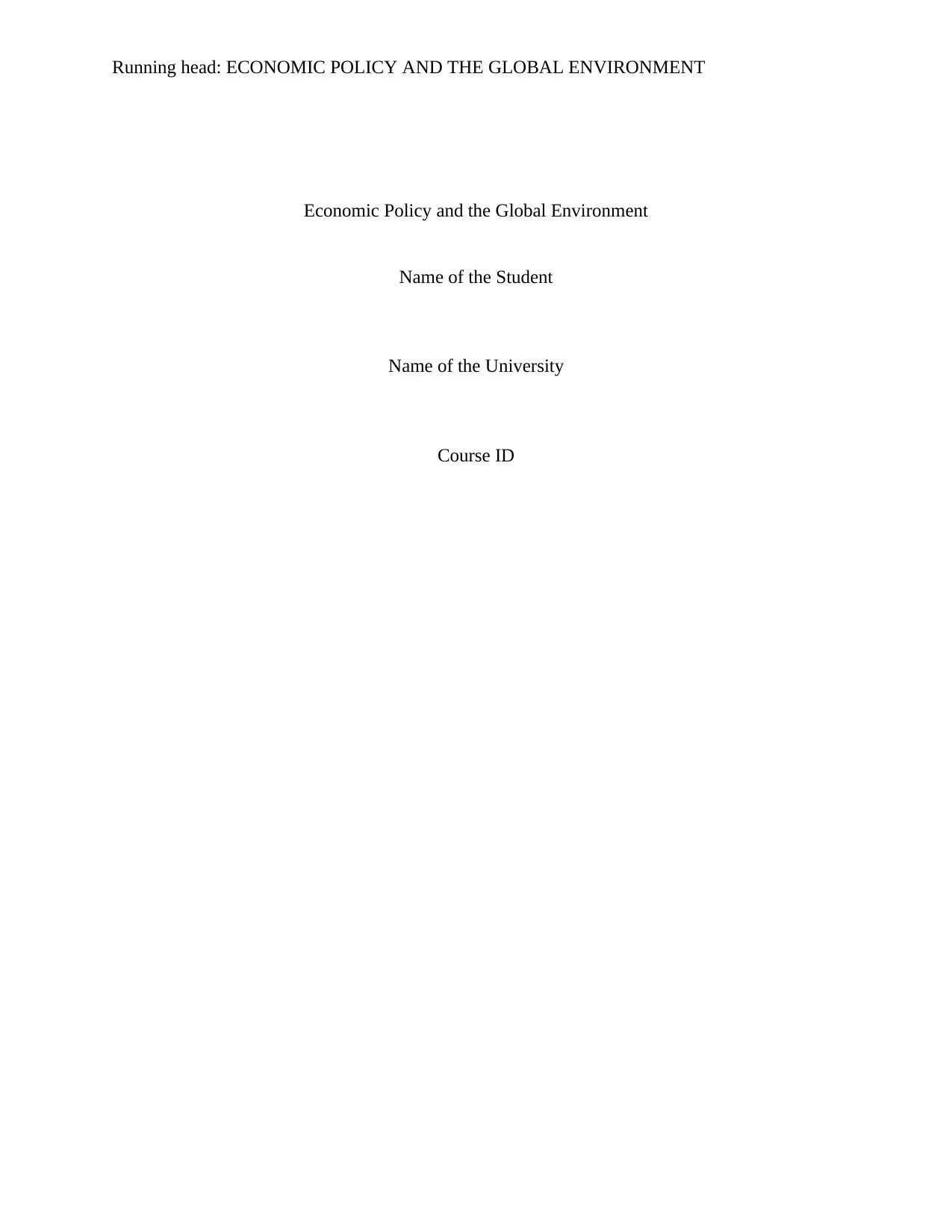
Running head: ECONOMIC POLICY AND THE GLOBAL ENVIRONMENT
Economic Policy and the Global Environment
Name of the Student
Name of the University
Course ID
Economic Policy and the Global Environment
Name of the Student
Name of the University
Course ID
Paraphrase This Document
Need a fresh take? Get an instant paraphrase of this document with our AI Paraphraser
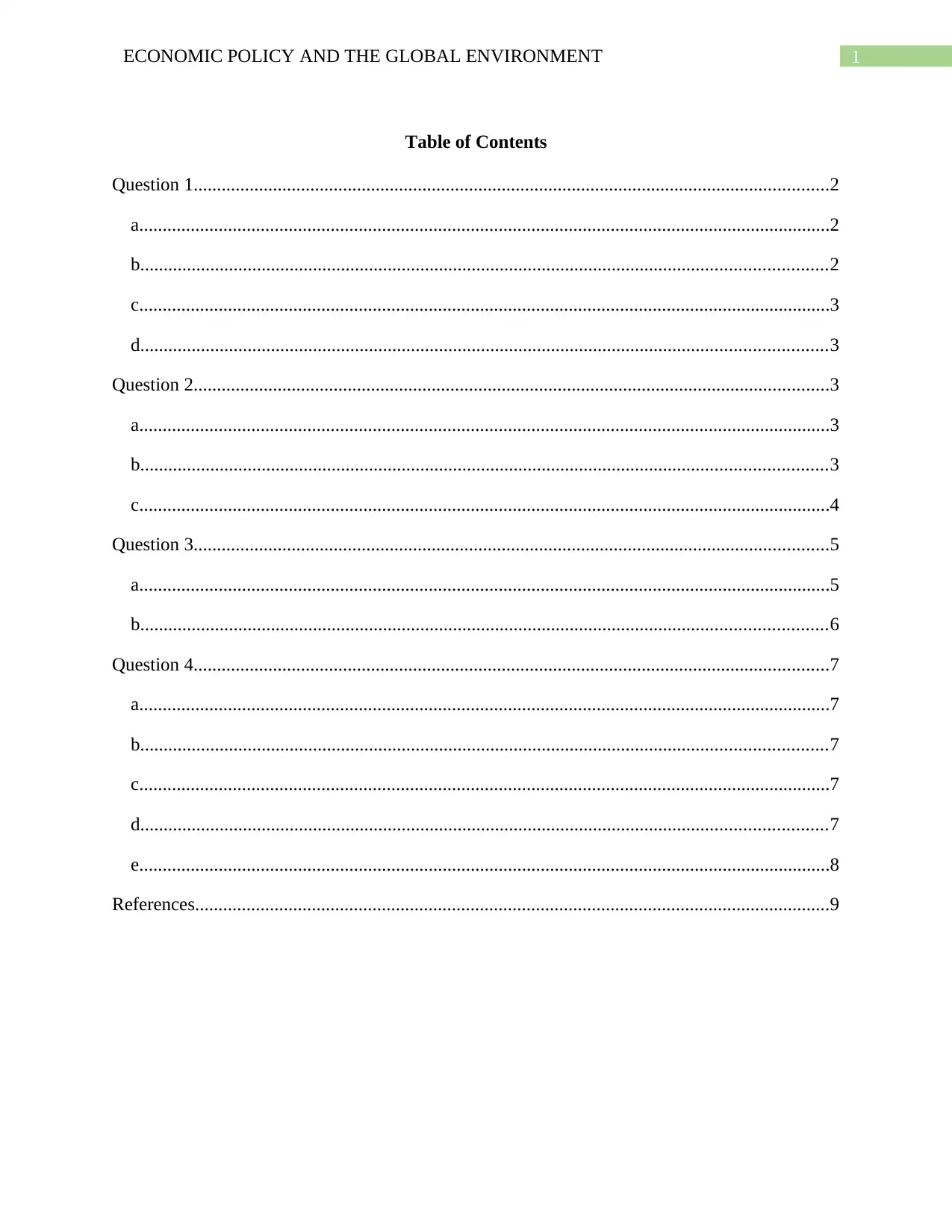
1ECONOMIC POLICY AND THE GLOBAL ENVIRONMENT
Table of Contents
Question 1........................................................................................................................................2
a....................................................................................................................................................2
b...................................................................................................................................................2
c....................................................................................................................................................3
d...................................................................................................................................................3
Question 2........................................................................................................................................3
a....................................................................................................................................................3
b...................................................................................................................................................3
c....................................................................................................................................................4
Question 3........................................................................................................................................5
a....................................................................................................................................................5
b...................................................................................................................................................6
Question 4........................................................................................................................................7
a....................................................................................................................................................7
b...................................................................................................................................................7
c....................................................................................................................................................7
d...................................................................................................................................................7
e....................................................................................................................................................8
References........................................................................................................................................9
Table of Contents
Question 1........................................................................................................................................2
a....................................................................................................................................................2
b...................................................................................................................................................2
c....................................................................................................................................................3
d...................................................................................................................................................3
Question 2........................................................................................................................................3
a....................................................................................................................................................3
b...................................................................................................................................................3
c....................................................................................................................................................4
Question 3........................................................................................................................................5
a....................................................................................................................................................5
b...................................................................................................................................................6
Question 4........................................................................................................................................7
a....................................................................................................................................................7
b...................................................................................................................................................7
c....................................................................................................................................................7
d...................................................................................................................................................7
e....................................................................................................................................................8
References........................................................................................................................................9
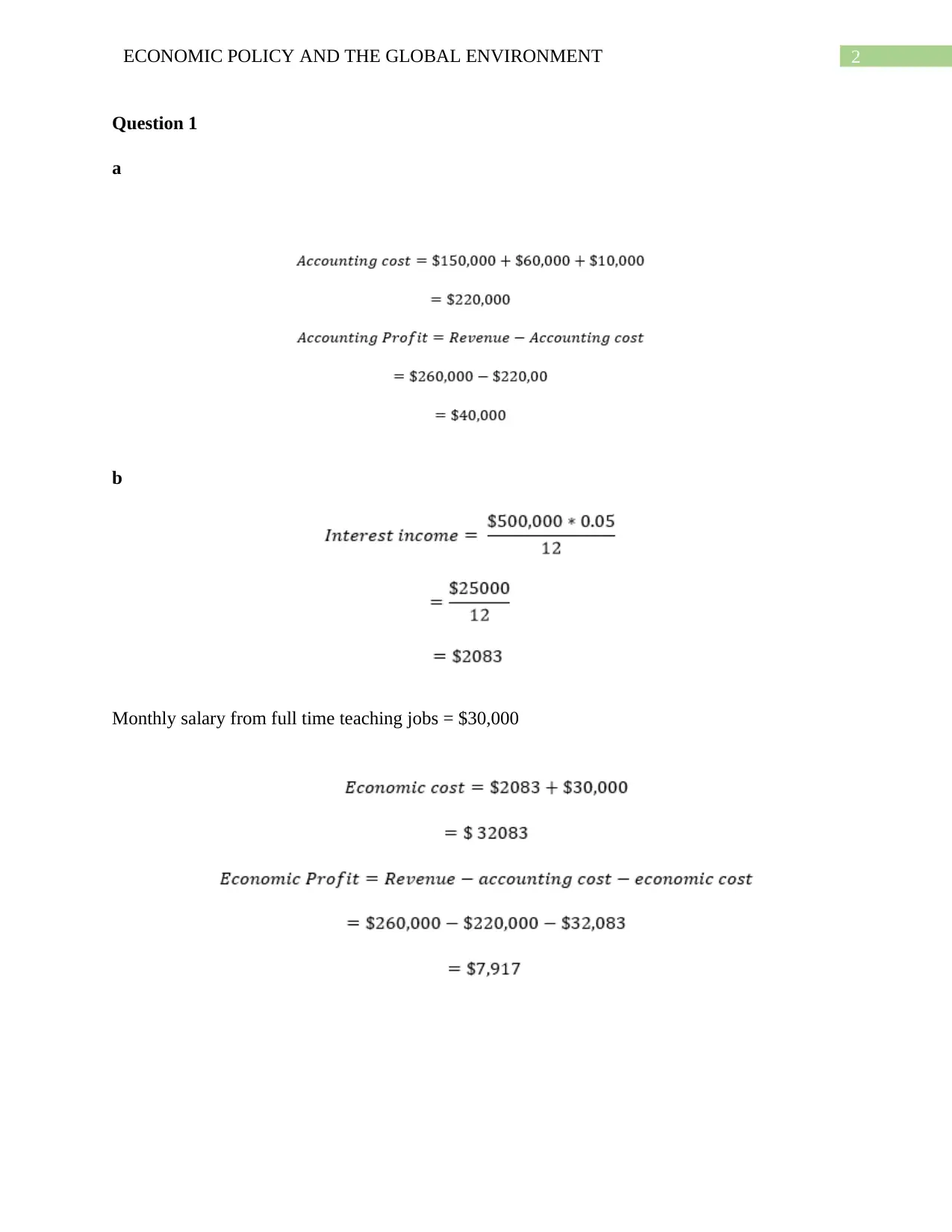
2ECONOMIC POLICY AND THE GLOBAL ENVIRONMENT
Question 1
a
b
Monthly salary from full time teaching jobs = $30,000
Question 1
a
b
Monthly salary from full time teaching jobs = $30,000
⊘ This is a preview!⊘
Do you want full access?
Subscribe today to unlock all pages.

Trusted by 1+ million students worldwide
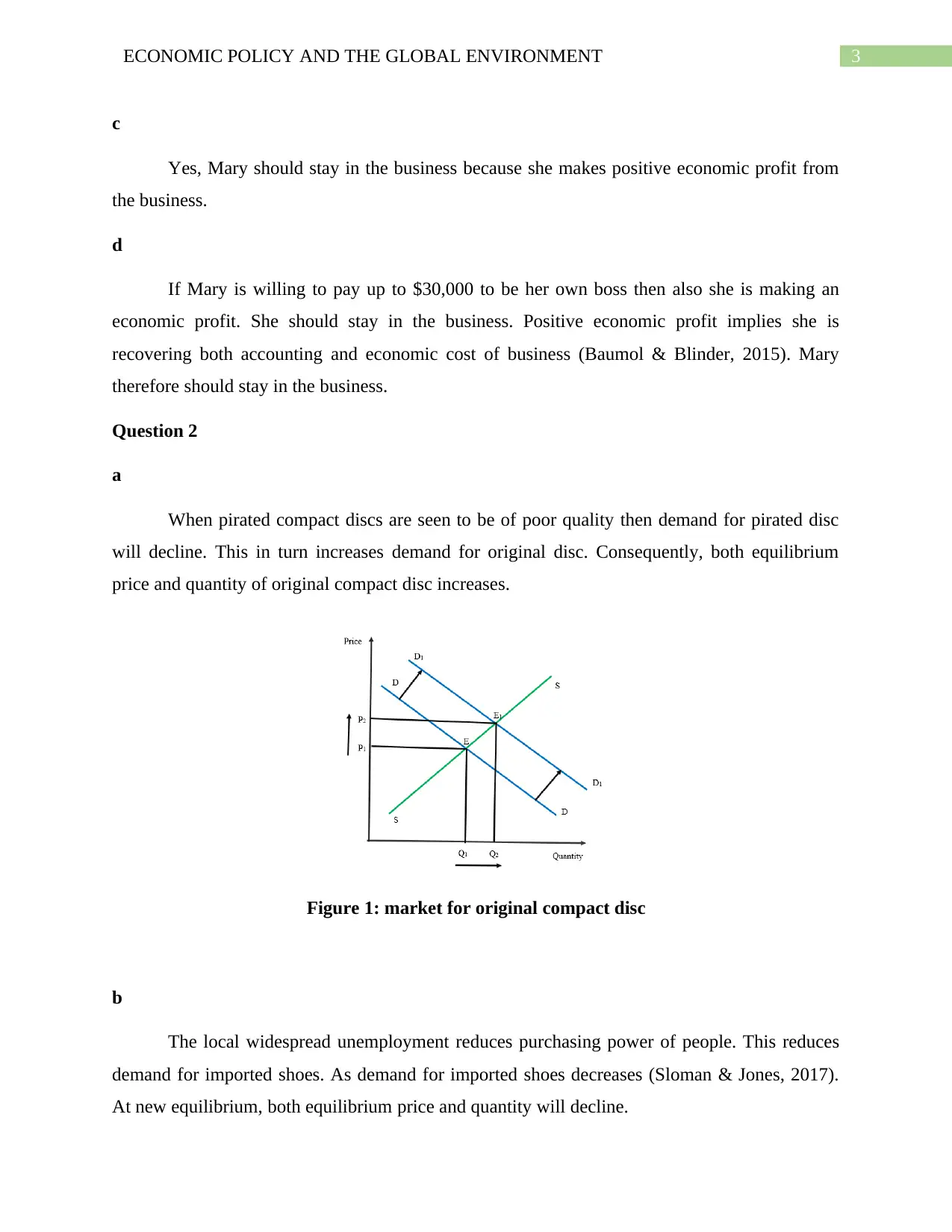
3ECONOMIC POLICY AND THE GLOBAL ENVIRONMENT
c
Yes, Mary should stay in the business because she makes positive economic profit from
the business.
d
If Mary is willing to pay up to $30,000 to be her own boss then also she is making an
economic profit. She should stay in the business. Positive economic profit implies she is
recovering both accounting and economic cost of business (Baumol & Blinder, 2015). Mary
therefore should stay in the business.
Question 2
a
When pirated compact discs are seen to be of poor quality then demand for pirated disc
will decline. This in turn increases demand for original disc. Consequently, both equilibrium
price and quantity of original compact disc increases.
Figure 1: market for original compact disc
b
The local widespread unemployment reduces purchasing power of people. This reduces
demand for imported shoes. As demand for imported shoes decreases (Sloman & Jones, 2017).
At new equilibrium, both equilibrium price and quantity will decline.
c
Yes, Mary should stay in the business because she makes positive economic profit from
the business.
d
If Mary is willing to pay up to $30,000 to be her own boss then also she is making an
economic profit. She should stay in the business. Positive economic profit implies she is
recovering both accounting and economic cost of business (Baumol & Blinder, 2015). Mary
therefore should stay in the business.
Question 2
a
When pirated compact discs are seen to be of poor quality then demand for pirated disc
will decline. This in turn increases demand for original disc. Consequently, both equilibrium
price and quantity of original compact disc increases.
Figure 1: market for original compact disc
b
The local widespread unemployment reduces purchasing power of people. This reduces
demand for imported shoes. As demand for imported shoes decreases (Sloman & Jones, 2017).
At new equilibrium, both equilibrium price and quantity will decline.
Paraphrase This Document
Need a fresh take? Get an instant paraphrase of this document with our AI Paraphraser
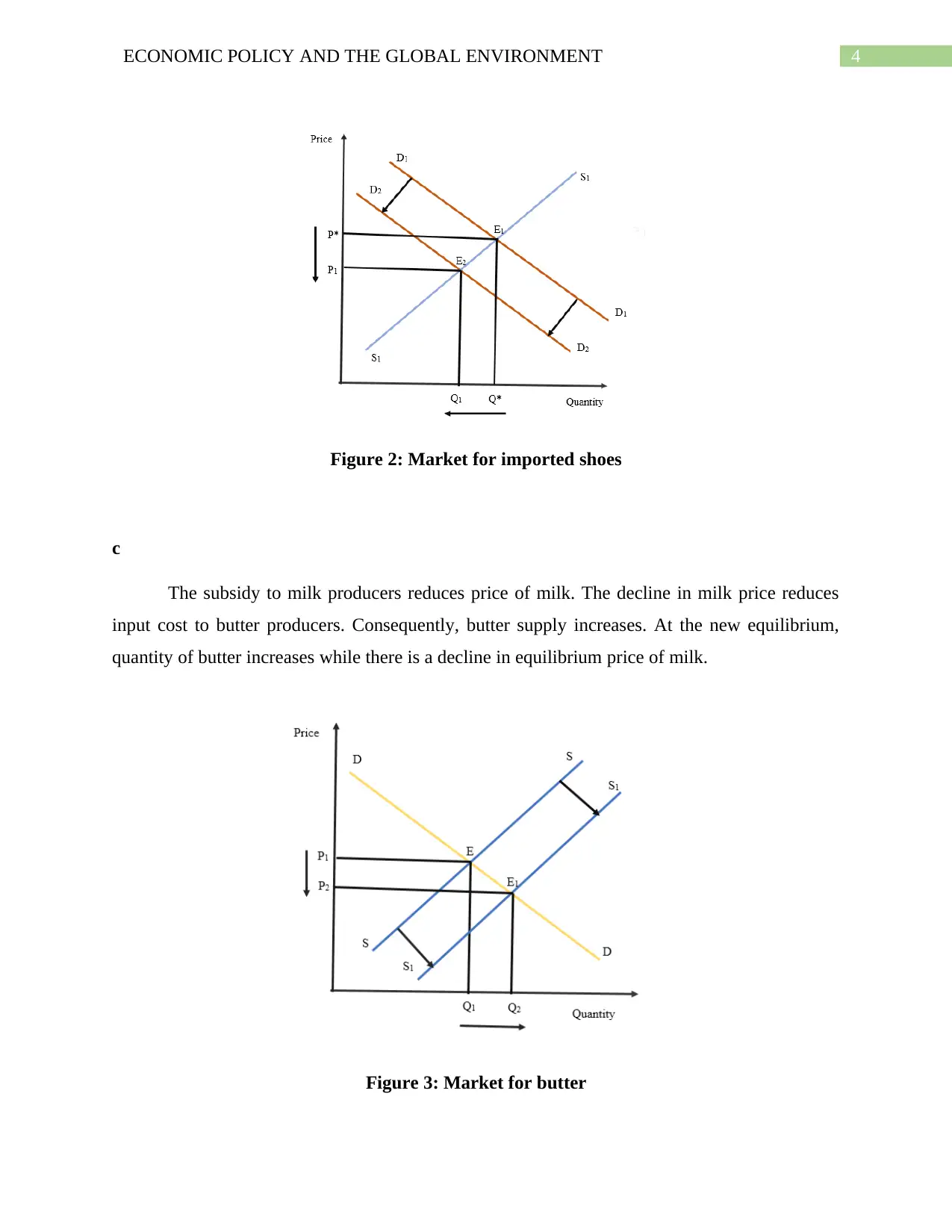
4ECONOMIC POLICY AND THE GLOBAL ENVIRONMENT
Figure 2: Market for imported shoes
c
The subsidy to milk producers reduces price of milk. The decline in milk price reduces
input cost to butter producers. Consequently, butter supply increases. At the new equilibrium,
quantity of butter increases while there is a decline in equilibrium price of milk.
Figure 3: Market for butter
Figure 2: Market for imported shoes
c
The subsidy to milk producers reduces price of milk. The decline in milk price reduces
input cost to butter producers. Consequently, butter supply increases. At the new equilibrium,
quantity of butter increases while there is a decline in equilibrium price of milk.
Figure 3: Market for butter
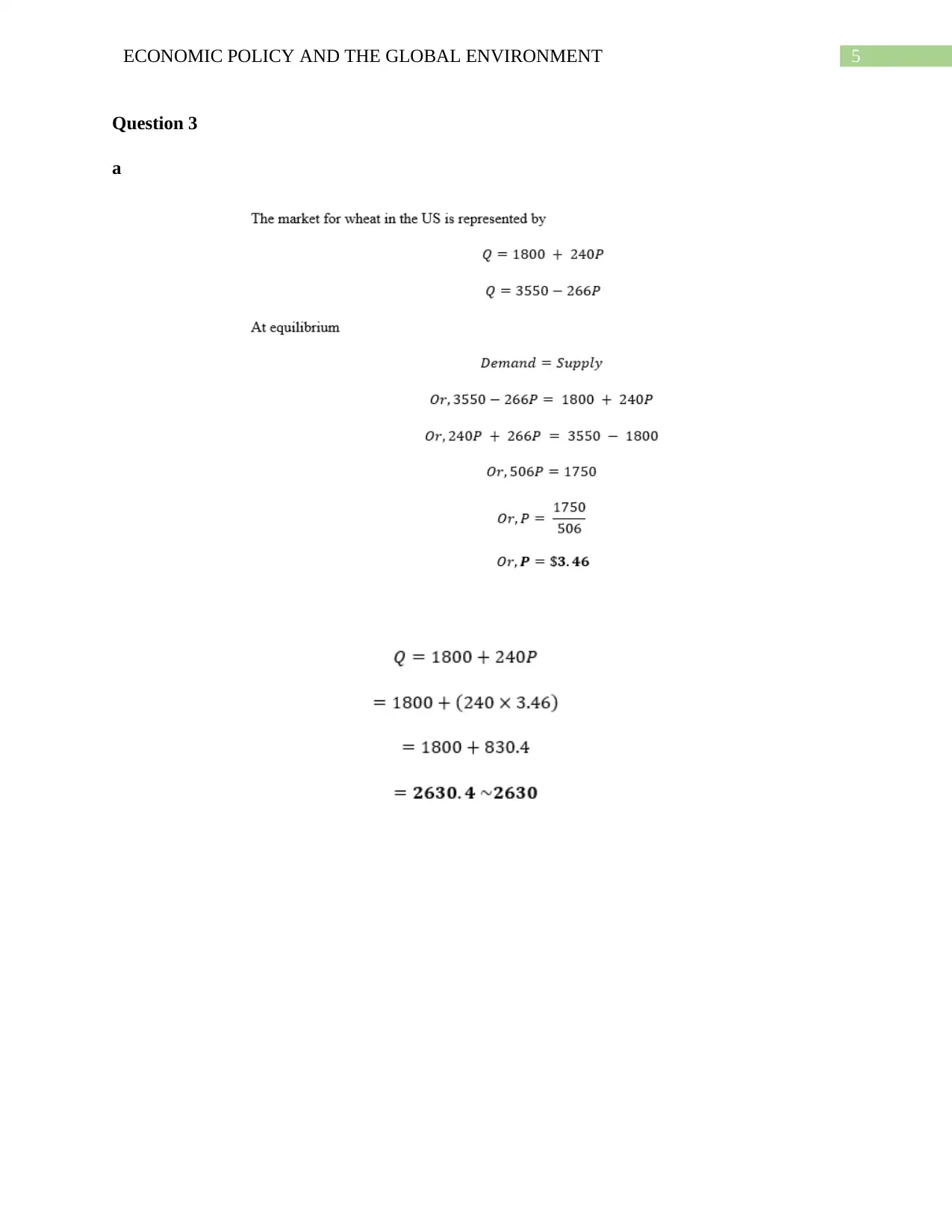
5ECONOMIC POLICY AND THE GLOBAL ENVIRONMENT
Question 3
a
Question 3
a
⊘ This is a preview!⊘
Do you want full access?
Subscribe today to unlock all pages.

Trusted by 1+ million students worldwide
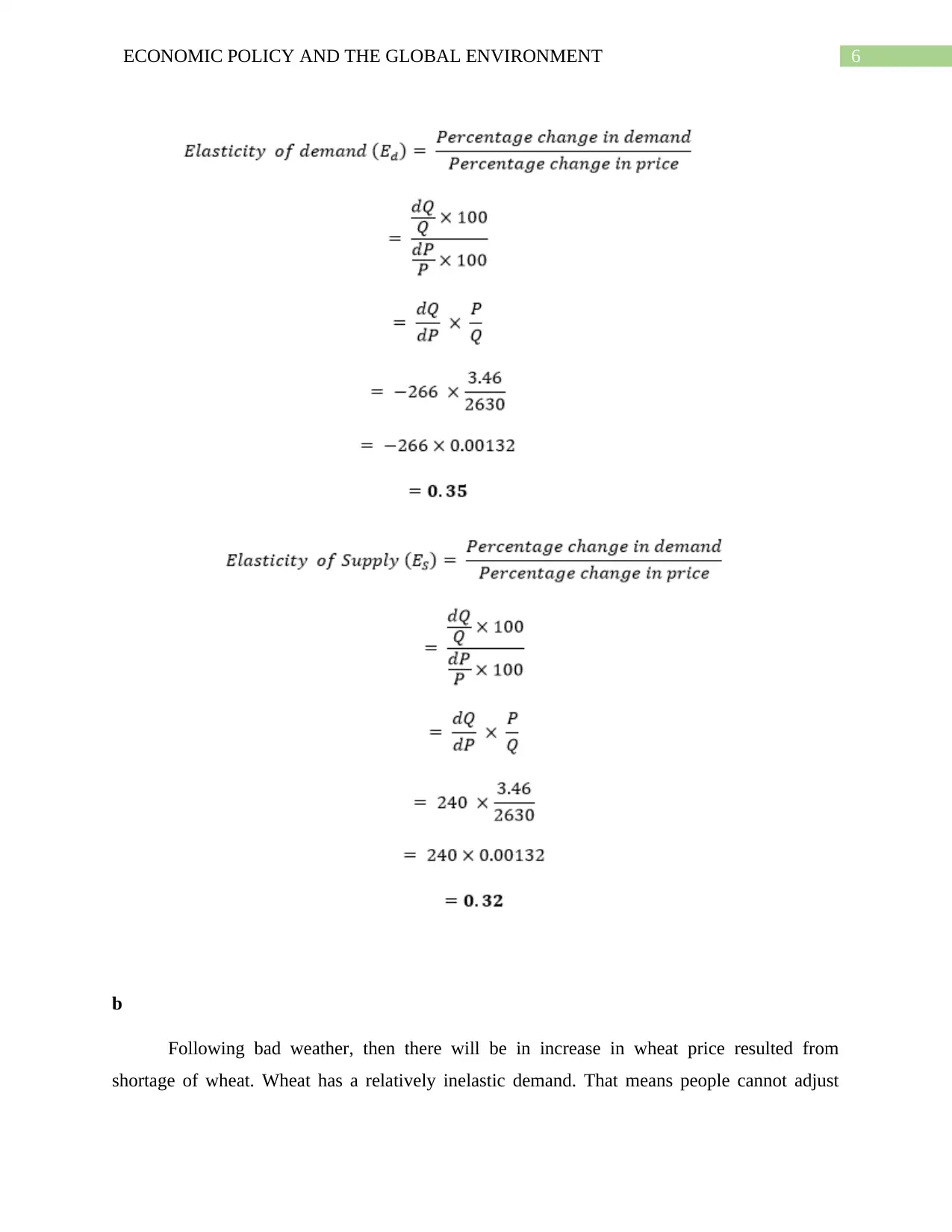
6ECONOMIC POLICY AND THE GLOBAL ENVIRONMENT
b
Following bad weather, then there will be in increase in wheat price resulted from
shortage of wheat. Wheat has a relatively inelastic demand. That means people cannot adjust
b
Following bad weather, then there will be in increase in wheat price resulted from
shortage of wheat. Wheat has a relatively inelastic demand. That means people cannot adjust
Paraphrase This Document
Need a fresh take? Get an instant paraphrase of this document with our AI Paraphraser
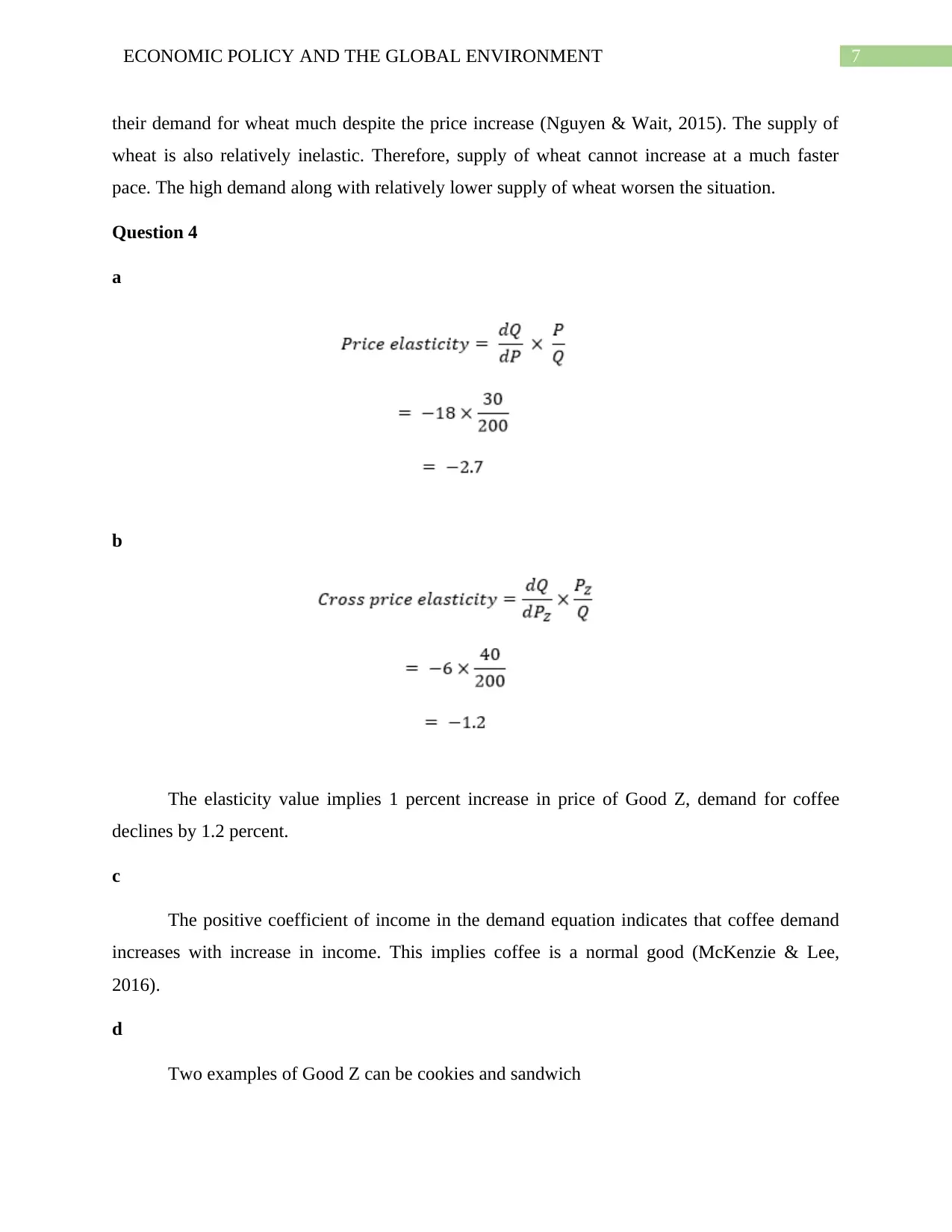
7ECONOMIC POLICY AND THE GLOBAL ENVIRONMENT
their demand for wheat much despite the price increase (Nguyen & Wait, 2015). The supply of
wheat is also relatively inelastic. Therefore, supply of wheat cannot increase at a much faster
pace. The high demand along with relatively lower supply of wheat worsen the situation.
Question 4
a
b
The elasticity value implies 1 percent increase in price of Good Z, demand for coffee
declines by 1.2 percent.
c
The positive coefficient of income in the demand equation indicates that coffee demand
increases with increase in income. This implies coffee is a normal good (McKenzie & Lee,
2016).
d
Two examples of Good Z can be cookies and sandwich
their demand for wheat much despite the price increase (Nguyen & Wait, 2015). The supply of
wheat is also relatively inelastic. Therefore, supply of wheat cannot increase at a much faster
pace. The high demand along with relatively lower supply of wheat worsen the situation.
Question 4
a
b
The elasticity value implies 1 percent increase in price of Good Z, demand for coffee
declines by 1.2 percent.
c
The positive coefficient of income in the demand equation indicates that coffee demand
increases with increase in income. This implies coffee is a normal good (McKenzie & Lee,
2016).
d
Two examples of Good Z can be cookies and sandwich
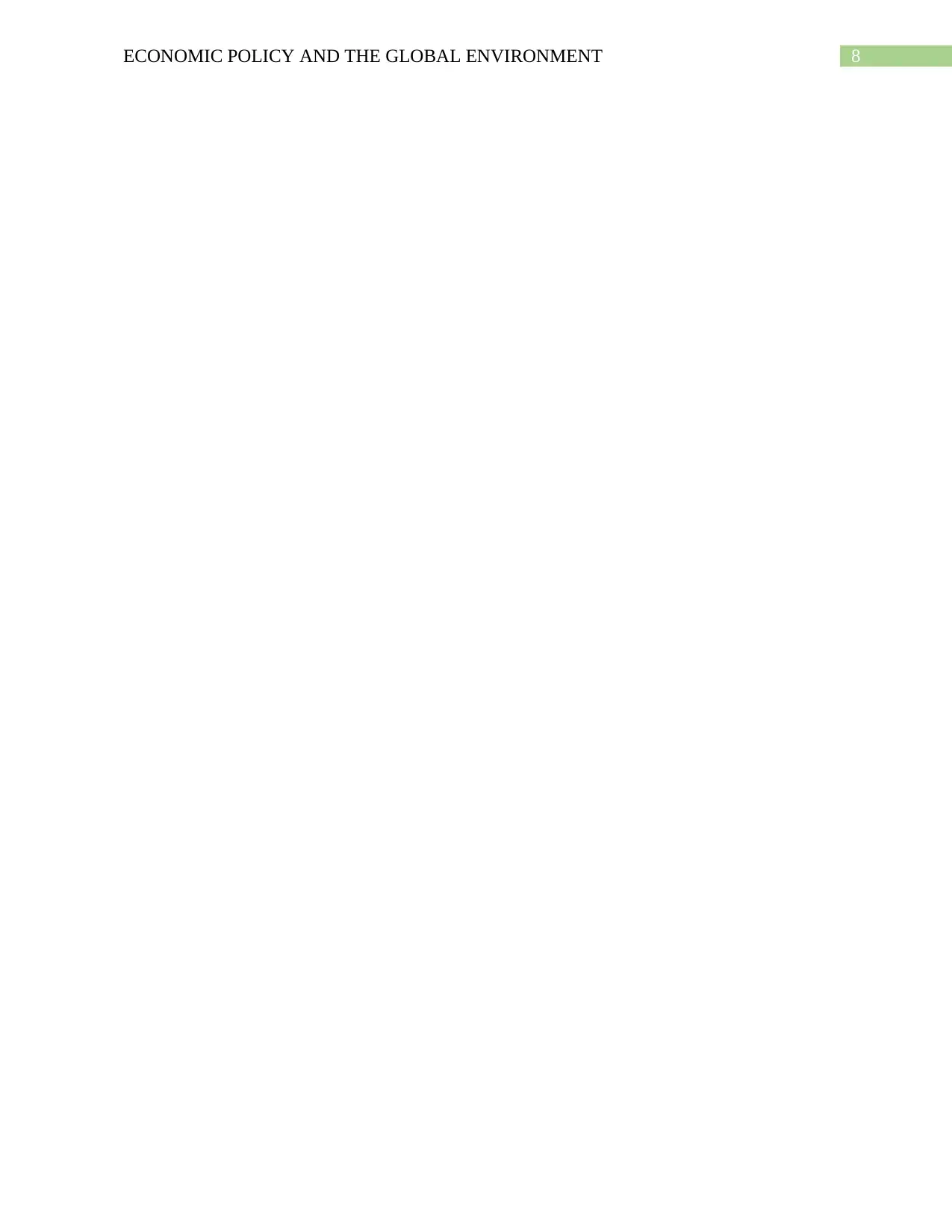
8ECONOMIC POLICY AND THE GLOBAL ENVIRONMENT
⊘ This is a preview!⊘
Do you want full access?
Subscribe today to unlock all pages.

Trusted by 1+ million students worldwide
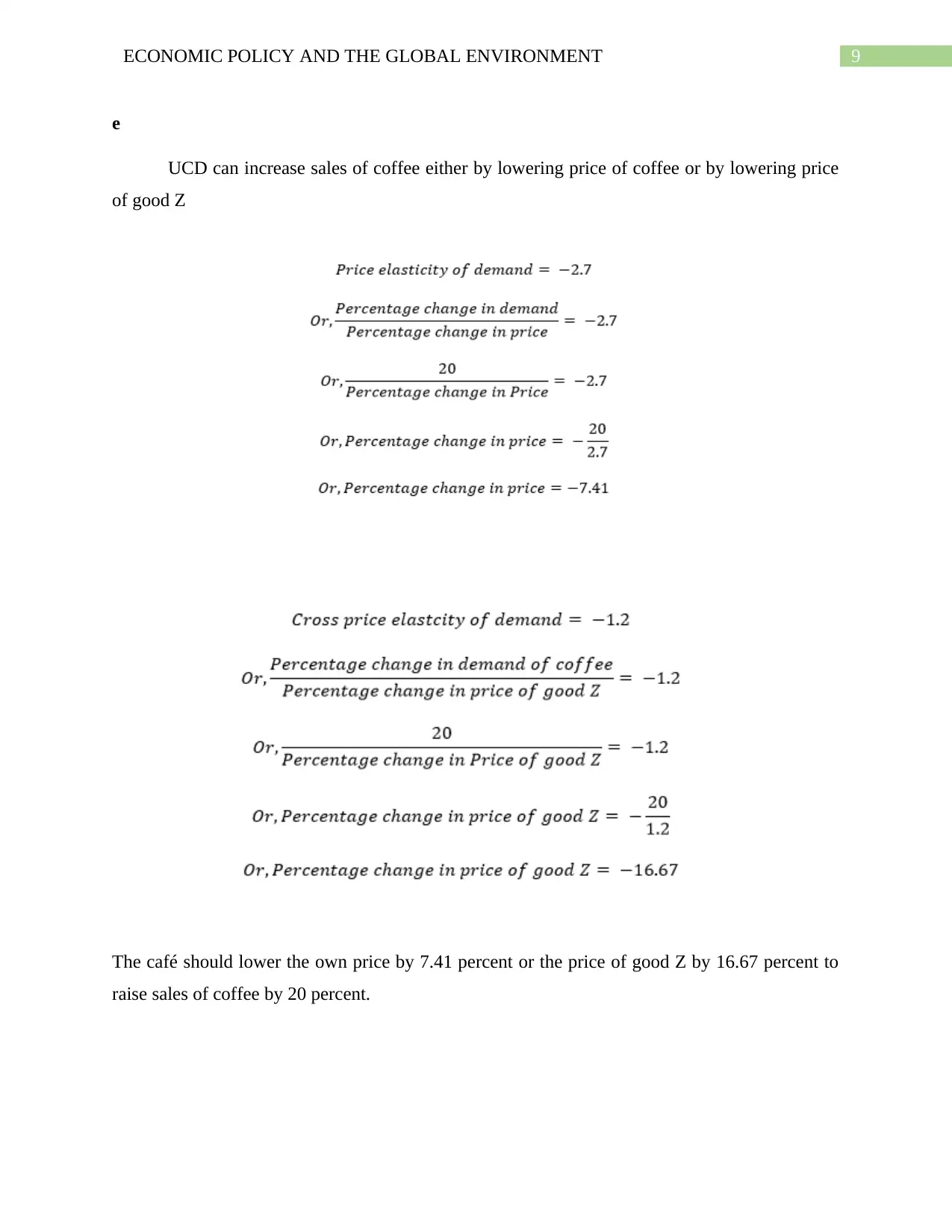
9ECONOMIC POLICY AND THE GLOBAL ENVIRONMENT
e
UCD can increase sales of coffee either by lowering price of coffee or by lowering price
of good Z
The café should lower the own price by 7.41 percent or the price of good Z by 16.67 percent to
raise sales of coffee by 20 percent.
e
UCD can increase sales of coffee either by lowering price of coffee or by lowering price
of good Z
The café should lower the own price by 7.41 percent or the price of good Z by 16.67 percent to
raise sales of coffee by 20 percent.
Paraphrase This Document
Need a fresh take? Get an instant paraphrase of this document with our AI Paraphraser
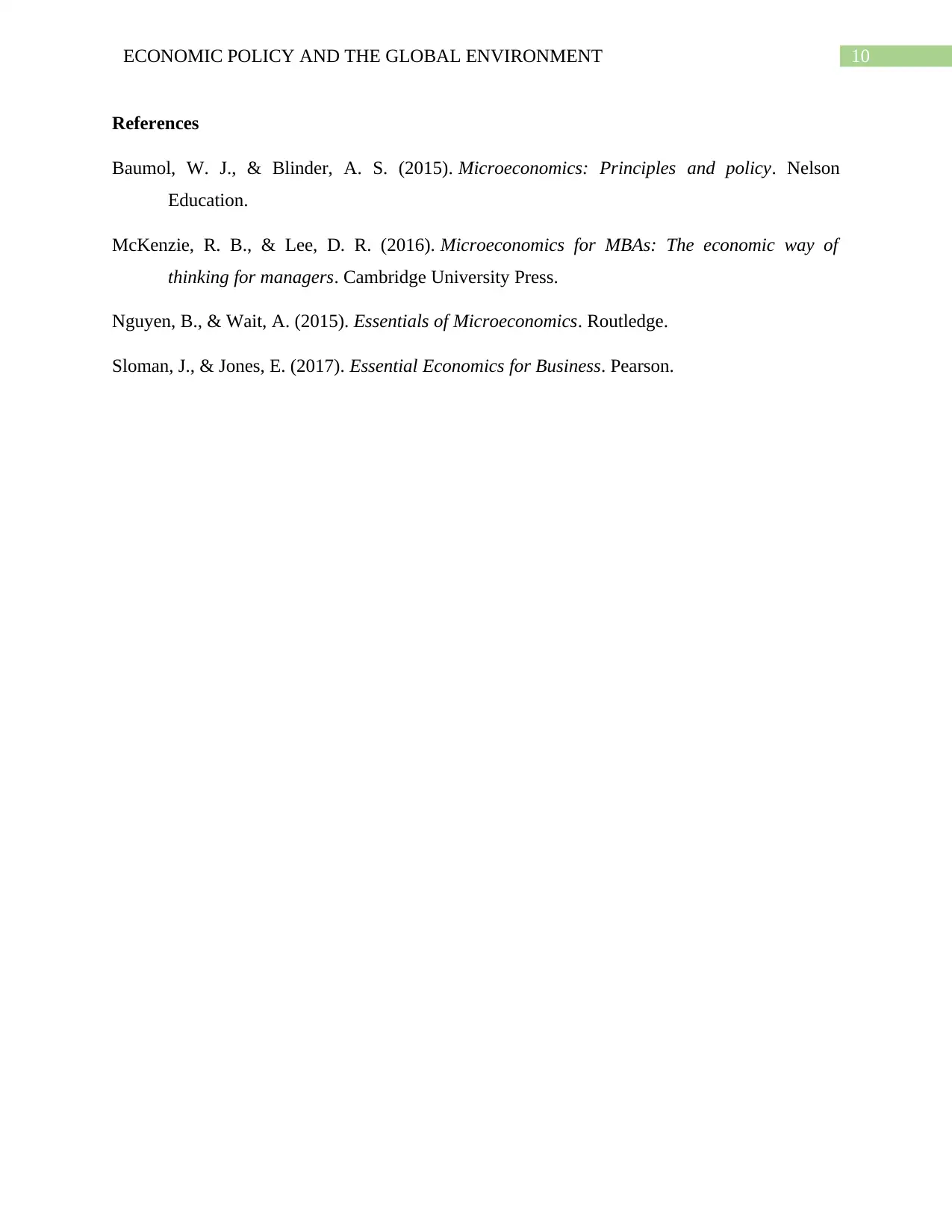
10ECONOMIC POLICY AND THE GLOBAL ENVIRONMENT
References
Baumol, W. J., & Blinder, A. S. (2015). Microeconomics: Principles and policy. Nelson
Education.
McKenzie, R. B., & Lee, D. R. (2016). Microeconomics for MBAs: The economic way of
thinking for managers. Cambridge University Press.
Nguyen, B., & Wait, A. (2015). Essentials of Microeconomics. Routledge.
Sloman, J., & Jones, E. (2017). Essential Economics for Business. Pearson.
References
Baumol, W. J., & Blinder, A. S. (2015). Microeconomics: Principles and policy. Nelson
Education.
McKenzie, R. B., & Lee, D. R. (2016). Microeconomics for MBAs: The economic way of
thinking for managers. Cambridge University Press.
Nguyen, B., & Wait, A. (2015). Essentials of Microeconomics. Routledge.
Sloman, J., & Jones, E. (2017). Essential Economics for Business. Pearson.
1 out of 11
Related Documents
Your All-in-One AI-Powered Toolkit for Academic Success.
+13062052269
info@desklib.com
Available 24*7 on WhatsApp / Email
![[object Object]](/_next/static/media/star-bottom.7253800d.svg)
Unlock your academic potential
Copyright © 2020–2025 A2Z Services. All Rights Reserved. Developed and managed by ZUCOL.


